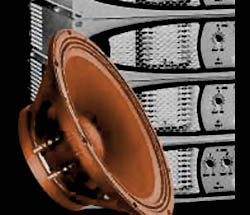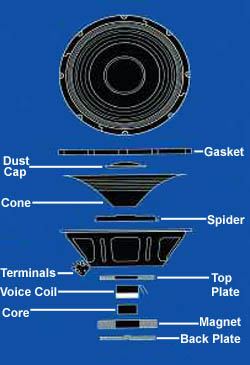(Editor’s Note: Eminence Speaker LLC contributed to this report.)
Cone drivers (also referred to as woofers and transducers in this article) are not overly complex. When an electrical current passes through a wire coil (the voice coil) in a magnetic field, it produces a force that varies with the current applied.
The cone, connected to the voice coil, moves in and out, creating waves of high and low air pressure. The coil and magnet assembly are the “motor structure” of the loudspeaker.
The movement is controlled by the loudspeaker’s suspension, which comprises the cone surround and the “spider”.
The surround and spider allow the coil to move freely along the axis of the magnet’s core (or “pole”) without touching the sides of the magnetic gap.
More important than knowing the details of how cone drivers work is the understanding of key data and what it means. Prior to 1970, there were no easy or affordable methods accepted as standard in the industry for obtaining comparative data about loudspeaker performance.
Recognized laboratory tests were expensive and unrealistic for the thousands of individuals needing performance information.
Standard measurement criteria were required to enable manufacturers to publish consistent data for customers to make comparisons between various loudspeakers.
Things began changing in the early 1970s, however, when several technical papers were presented to the Audio Engineering Society (AES) that resulted in the development of what we know today as Thiele-Small Parameters.
The authors of the papers – A.N. Thiele and Richard H. Small – devoted considerable effort to showing how the following parameters define the relationship between a cone driver and a particular enclosure.
These parameters can be invaluable in making choices because they can tell you far more about the transducer’s real performance than the basic benchmarks of size, maximum power rating or average sensitivity.
Let’s have a look at the parameters defined by Mr. Small and Mr. Thiele. (And note that we listed Mr. Small first this time – bet he doesn’t get that very often!)
Fs: The free-air resonant frequency of a cone driver. Simply stated, it’s the point at which the weight of the moving parts of the speaker becomes balanced with the force of the driver suspension when in motion.
If you’ve ever seen a piece of string start humming uncontrollably in the wind, you have seen the effect of reaching a resonant frequency. It’s important to know this information so that you can prevent your enclosure from ‘ringing’.
















